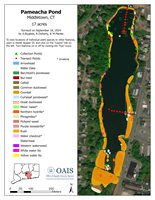
Pameacha Pond, Middletown - 2024
Pameacha Pond is a 17-acre pond in Middletown, CT located along South Main Street (Route 17). It is highly developed with homes on the western side and businesses and S. Main Street on the eastern side. The dam was recently replaced by the City of Middletown. There is no boat access except for carry-ins from shorefront homes or possibly from the adjacent roads.
CAES OAIS conducted its first aquatic vegetation survey of Pameacha Pond on September 18, 2024. A total of 19 plant species were documented. Of these, six were invasive: curlyleaf pondweed (Potamogeton crispus), minor naiad (Najas minor), Northern hydrilla (Hydrilla verticillata ssp. lithuanica), phragmites (Phragmites australis), purple loosestrife (Lythrum salicaria), and water chestnut (Trapa natans). Curlyleaf pondweed senesces in mid-summer, so a Spring survey is required to accurately document its abundance. Minor naiad is an annual, low-growing, invasive aquatic plant that is often found in the shallows. One of the larger patches was found on the northeastern side of the pond. Northern hydrilla was the most abundant invasive species. It is thought to have been introduced to North America in the Connecticut River where it was discovered in 2016. Thus, the population in Pameacha Pond likely came from the Connecticut River. Possible modes of introduction include waterfowl, paddle boat usage, or fishing. Phragmites and purple loosestrife are invasive wetland plants found on Pameacha Pond’s shoreline. Phragmites occurred at the southern end of the pond while purple loosestrife was found along the northwest shore.
There were two small patches of water chestnut in the pond, one at the southern end and one at the northern end. Water chestnut is a rooted annual that grows large, hard seeds, or nutlets, with sharp spines. Seeds germinate in the spring and can produce 10-15 stems with floating rosettes and each rosette can produce up to 20 nutlets. If left unchecked, water chestnut can multiply quickly. Fortunately, water chestnut can be successfully managed by hand pulling. Because the seeds can remain viable in the sediment for up to 12 years, eradication of the plant may require years of dedicated volunteer work. It is crucial to pull the plants before they drop their seeds. Ideally, the plants would be pulled in June and the area would be occasionally checked throughout the summer in case additional plants sprout.
Thirteen native plant species documented in Pameacha Pond. Coontail (Ceratophyllum demersum) was the dominant species. It was found throughout the littoral zone of the pond and was matted on the surface. Watermeal (Wolffia sp.) occurred on the surface of the matted coontail and was often mixed with great duckweed (Spirodela polyrhiza. There were five emergent species along the shoreline including arrowhead (Sagittaria sp.), bur-reed (Sparganium sp.), cattail (Typha sp.), pickerelweed (Pontederia cordata), and rush (Juncas sp.), and two floating leaf species including white waterlily (Nymphaea odorata) and yellow waterlily (Nuphar variegata). Berchtold’s pondweed (Potamogeton berchtoldii) and western waterweed (Elodea nuttallii) were found in one location on the northeastern side of the pond and was mixed with minor naiad.
| Species recorded in our 2024 survey of Pameacha Pond. Scientific Names *Invasive Species |
||
| Arrowhead | Great duckweed |
Water chestnut* |
| Berchtold's pondweed |
Minor naiad* |
Watermeal |
| Bur-reed | Northern hydrilla* |
Western waterweed |
| Cattail | Phragmites* | White water lily |
| Common duckweed |
Pickerelweed | Yellow water lily |
| Coontail | Purple loosestrife* |
|
| Curlyleaf pondweed* |
Rush | |


